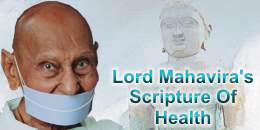
If these types of chitta alone had been related to our life, we would never be successful in anything. This has the other side too, resulting from the pure vibrations of the subtle body. This side in the anavarana chitta. There is not just the cover; there is the exposure as well. It is only because of the exposure that we are able to develop our knowledge. Our consciousness is not completely covered.
It has been said that an infinite part of our consciousness is always exposed. It is never covered. If consciousness is completely covered, then jeeva (soul or living substance) would become ajeeva (non-soul or non-living substance). In that situation, there would be no difference at all between jeeva and ajeeva. The anavarana chitta also is always active; it carries on its on work and does not let consciousness become completely covered.
Then there is nirvighna chitta. How would man ever be able to act at all if there are only obstacles and impediments all around? The nirvighna chitta cuts through the obstacles. Man is able to do lots of things because the nirvighna chitta always remains active.
The third is the samyag-darshan chitta. It develops the right outlook in the individual. It accepts the element as the element, considers the reality from the point of view of reality. It is because of this that it is possible to have positive feelings and positive thoughts.
The fourth is the veetaraga chitta. No individual is without character altogether. Character does develop in every individual to a certain extent. This development takes place because of the dispassionate chitta.
Context of Health
Let us now think from the point of view of health. The avarana chitta is not directly connected with health. It is connected with knowledge. But the antaraya chitta, mithyatva chitta and most of all, the moha-chitta are connected with our health. Let us divide the chitta into two parts: pure chitta and impure chitta. The purity of the chitta is related to the purity of the emotions and of the mind. Actually, the mind does not become pure or impure. It is not the function of the mind. The function of the mind is to remember, imagine and think. It is neither pure nor impure. It becomes pure or impure because of the flow of the chitta. When the flow of the chitta gets transformed into the bhava, the mind becomes pure or impure. When the bhava passes into the mind, we say that the mind is pure or impure, good or bad.
As a matter of fact, nothing about the mind is either pure or impure. The wind is blowing. Is it hot or cold? If there is too much heat, the wind will be hot. If there is a cold wave, the wind will be cold. We cannot say in absolute terms if the wind is cold or hot. We can only make a relative statement. The wind will be cold if there is snowfall or rain. In the terrible heat of June or July, the wind will become hot. That is how it is with the mind also, because the mind has no independent existence. The chitta has an independent existence, mind has no independent existence. Who gives the direction that if the mind is everything, if the mind has an independent existence, then control your mind. From where does this direction come? It comes from the chitta. It is the function of the chitta either to restrain the mind or leave it free. If the chitta is pure and it has decided to restrain the mind, then it would resort to dhyana (meditation), keep the mind on the course of concentration and keep it under check. The chitta is the master of the mind. During the process of meditation comes the stage of thoughtless meditation. If the mind has an independent existence, what purpose would be served by dhyana with freedom from thought? Would it mean the end of consciousness? But there can never be the end of consciousness. Even in the absence of thought, its existence is constantly experienced.
Acharya Ramachandra expressed a beautiful thought when he said that the Jains do not regard shunya (blank mind) as meditation. The non-existence of consciousness is not dhyana but stupor. When there is stupor, there is no dhyana through consciousness. In that state, there is no existence of the mind, no alternative of the mind, there is no thought coming in the mind. Where there is constant experience of consciousness and an awareness of the chitta, there is dhyana. Otherwise, there would be no distinction between stupor and dhyana. When there is constant meditation of one's existence and his consciousness, the state of dhyana is achieved. In the state of absence of thought there is no mind, but there is dhyana, because the awareness about existence or consciousness becomes acute in that state.
 Acharya Mahaprajna
Acharya Mahaprajna

